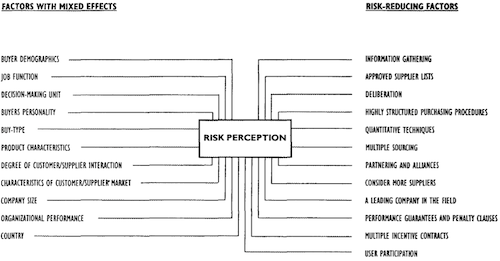Organizational Risk Perception and Reduction
Today I read a rather old article from 1995 about “Organizational Risk Perception and Reduction: A Literature Review” by Vincent-Wayne Mitchell, now at the Cass Business School in London. I present it here since I think most of the concepts and strategies are still valid.
Objective and Methodology
The objective of Mitchell was to show the status of current research on how risks are perceived in organizational buyer behavior and what can be done to reduce these risk. He therefore conducts a review of the current literature.
Risk Perception
In figure 1 Mitchel aggregated the factors which enhanced risk perception and how it could be reduced. In the following I focus on the available strategies for reducing risks:
- Information gathering
This strategy is obviously used when perceived risks are high, it can be categorized by the amount of information sought and the nature of it. - Approved supplier lists
This has been a key strategy for a long time now, already in 1995 more than 63% used it. - Group decision making
There are still different results on wether this strategy can reduce risks, in any case this tool has to be carefully designed for the company using it. - Deliberation
Time spent on high risk purchasing decisions is usually significantly higher than on the low risk cases - Highly structured purchasing procedures
A highly structured purchase procedure acts as a defence mechanism, diffusing or precluding high levels of psychosocial risk - Quantitative Techniques
It can be argued that the implementation of expert systems will lead to less complex and political decision processes, which also might lead to less risk. - Multiple sourcing and split procurements
is a typical strategy to reduce risk of interruptions of one supplier - Partnering and Alliances
Long term relationships and the trust involved can lead to reduced risk, as long as dependence is not to high - Consider more suppliers
If the perceived risk increases the number of considered suppliers is increased - A leading company in the field
Buying from a “brand” company might reduce risks for industrial buyers as well. - Performance Guarantees and Penalty Clauses
For a supplier a performance guarantee is sometimes the best way to reduce perceived risks on the client side - Multiple incentive contracts This strategy can help to align the goals between supplier and buyer.
- User participation
Involving users in the purchase decision can help to reduce risk in two ways. First, it can bring specialized knowledge to bear on a decision. Second, it gives users a stake in the decisions affecting them. - Source loyalty
Buying from known sources can reduce risks as well
Conclusion
Again, I am wondering why the title of the article has to be so misleading. Of course it is on organizational risk perception, but it focusses solely on buy side risks. But purchasing is also an important corporate function so it is surely no time wasted.
But I am also missing a clear differentiation between the terms “perceived risk” and “risk”. Here the discussion is completely lacking: There exists a theory, that all risk can always be only seen as perceived risk, since a measure for uncertainty can never be given with certainty, even for a dice you never know if it is a perfect one. The strategies also show this lack of discussion, there are some strategies concerned with reducing the actual supply side risk (like information gathering) and there are strategies which mainly deal with reducing the perceived risk of the buyer (like having a structured process to support the decision maker).
As a third critique I am missing some more categorization of the strategies as well, several strategies could be aggregated under the topic “if there is more risk, you have to invest more time for analysis” and “usage of trust to reduce risk”.
Mitchell, V. (1995). Organizational Risk Perception and Reduction: A Literature Review British Journal of Management, 6 (2), 115-133 DOI: 10.1111/j.1467-8551.1995.tb00089.x









Add new comment